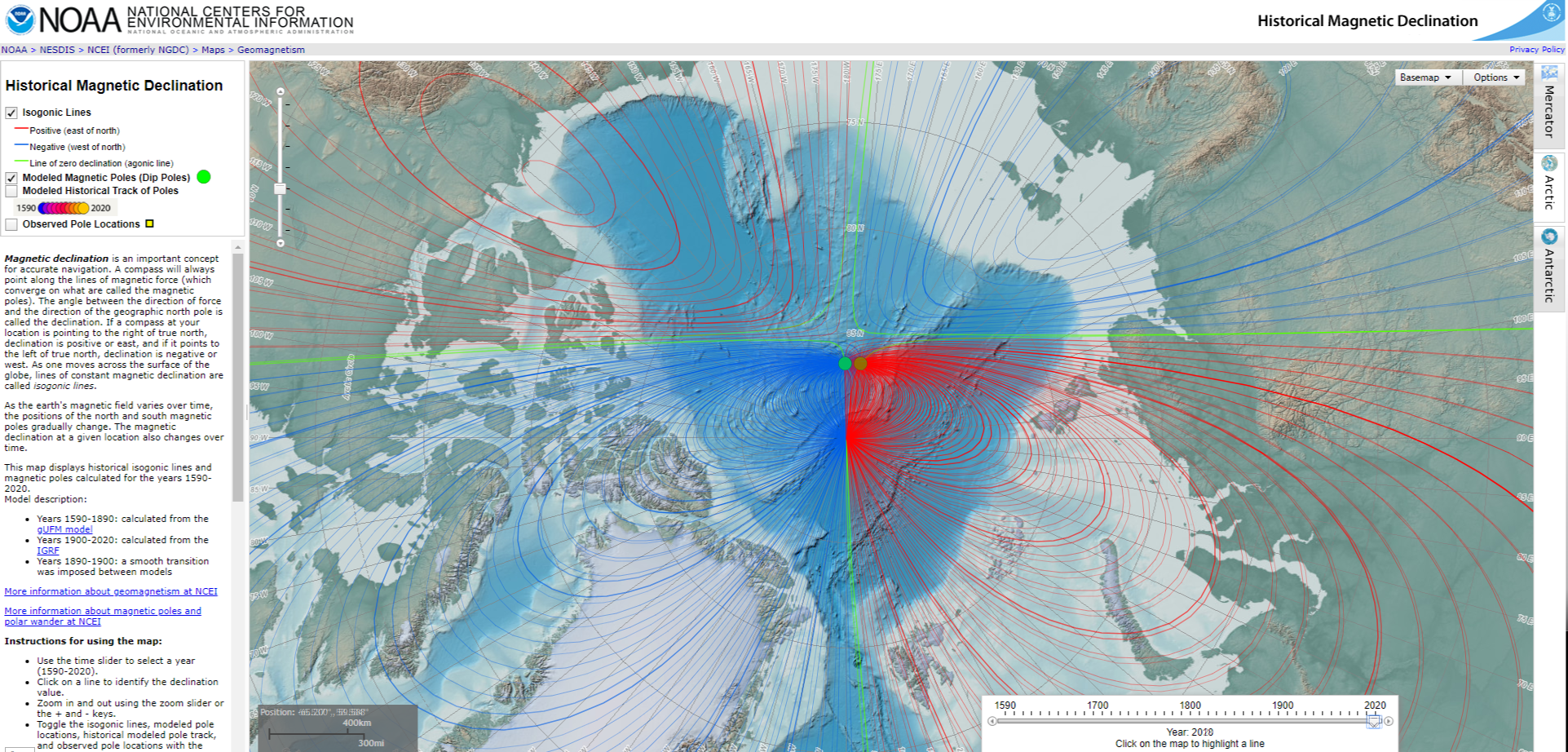|
|
Post by 🖕🏿Mörön🖕🏿 on Mar 28, 2018 21:55:16 GMT -5
maps.ngdc.noaa.gov/viewers/historical_declination/Really cool site that shows where the poles have been in the past going back to 1590 and their present positions. Lots of movement recently, especially in the Arctic. And see for yourself, the southern magnetic pole isn't even on the Antarctic continent... 
|
|
|
|
Post by sari on Mar 28, 2018 22:34:49 GMT -5
That explains a lot! I've wondered for a while how southern NZ can get auroras, because it seemed so far from the pole, so the bad lazy explanation that I came up with was that auroras were more "intense" around the south pole than the north, like the weather.
|
|
|
|
Post by knot on Mar 29, 2018 18:34:11 GMT -5
Sometimes even Central Victoria, Southeastern NSW and Southern SA (~37° S) can see the Aurora Australis/Southern Lights. There's another point the Southern Hemisphere cops over the Northern!
|
|
|
|
Post by knot on Mar 29, 2018 20:48:37 GMT -5
Aurora Australis/Southern Lights in Goulburn NSW, Southern Tablelands (34.7° S). Bloody splendid!
|
|
|
|
Post by 🖕🏿Mörön🖕🏿 on Mar 29, 2018 21:30:31 GMT -5
Aurora Australis/Southern Lights in Goulburn NSW, Southern Tablelands (34.7° S). Bloody splendid! beautiful and amazing display, especially for the latitude. I've only seen them twice, in Anchorage. My auroral virginity was broken in January 2010 and it was unfortunately cloudy but the aurorae were so strong that the clouds were red. The second time was in May and they were green but less strong with a clear sky. Still amazing to see them in May since it's not so dark there in that month. |
|
|
|
Post by Babu on Mar 31, 2018 5:46:41 GMT -5
Sometimes even Central Victoria, Southeastern NSW and Southern SA (~37° S) can see the Aurora Australis/Southern Lights. There's another point the Southern Hemisphere cops over the Northern! Aren't the two magnetic poles antipodal? I.e. you'd be able to see the aurora at 38'N at the right longitude, am I right? |
|
|
|
Post by 🖕🏿Mörön🖕🏿 on May 14, 2020 0:23:42 GMT -5
Unsurprisingly, the northern magnetic pole has continued to move toward Russia but the rate is still pretty quick. I've overlaid 2018 and 2020 on one image here so the change can be easily seen. The southern magnetic pole has barely moved in comparison.  |
|
|
|
Post by 🖕🏿Mörön🖕🏿 on Dec 16, 2020 18:53:34 GMT -5
The Neptune bit is not strictly related to our planet but it has implications for our planet, going forward:
|
|
Deleted
Deleted Member
Posts: 0
|
Post by Deleted on Dec 16, 2020 21:44:53 GMT -5
🖕🏿Mörön🖕🏿 I'm not an astronomy expert, so could you please explain a bit of what this reversal could mean for us?
|
|
|
|
Post by 🖕🏿Mörön🖕🏿 on Dec 16, 2020 21:59:38 GMT -5
🖕🏿Mörön🖕🏿 I'm not an astronomy expert, so could you please explain a bit of what this reversal could mean for us? It means our star and system of planets are moving into an area of the galaxy where a magnetic reversal will happen. I'm by no means an expert either, especially on the astronomical side of things. It appears Pluto and now Neptune have seen some behavioral abnormalities. No one alive today knows the specifics on how it will play out though, and we won't until it is playing out in real time. That aspect is all very theoretical. Probably nothing good though. And from the evidence we have of magnetic reversals, the actual magnetic fluctuations are not gradual, but instead rapid which will lead to some very abnormal phenomena. Also, overarching magnetic reversals aren't over and done with so quickly, it can take 100s to 1000s of years for it to be completed and for the magnetic poles to become stabilized. I hope that makes sense... But yeah, Vancouver might actually become an "east coast" climate!   |
|
|
|
Post by 🖕🏿Mörön🖕🏿 on Dec 28, 2020 21:39:20 GMT -5
|
|
|
|
Post by 🖕🏿Mörön🖕🏿 on Jul 14, 2021 1:15:23 GMT -5
Uh oh
|
|